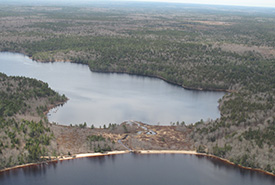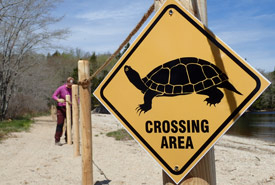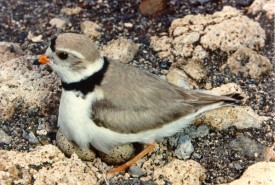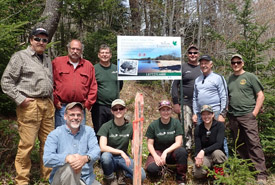Human dimensions of conservation management

Aerial view of snapping turtle beach (Photo by NCC)
There is a strange socially well-adapted mammalian species that lives in a variety of habitats all over the world. From a conservation perspective, this species is thriving and its population numbers are steadily climbing. Generally, the species is very resilient, opportunistic and readily able to adapt or modify its behaviour in response to a changing environment.
This species behaves much like a highly problematic invasive species, and has the potential to destroy any habitat into which it moves. Curiously enough, this species also has the capacity to improve and restore habitat.
Although this wide-ranging species has the greatest capacity to wreak havoc on any habitat that it infiltrates, it is one of the least-studied species by conservation scientists. The two–legged, furless species is called…homo sapiens, or human.
In the Atlantic Region of the Nature Conservancy of Canada (NCC), our dynamic group of go-getters is always trying to accomplish the most effective conservation with the resources we have. Staff are going full steam ahead, striving to meet goals. However, even with a hectic schedule, we are always open to exploring new ideas that may lead to more effective conservation. One of these ideas is to use the science of human dimensions to help solve many of our most challenging issues.
This year, as a first step to learning more, the Atlantic Region of the Nature Conservancy of Canada decided to hold a two-day open workshop facilitated by Memorial University professor Alistair Bath. An associate professor at Memorial University in St. John’s Newfoundland, Mr. Bath has more than 20 years’ experience in human-wildlife conflicts and human dimensions in natural resource management issues.
The workshop focused on the human dimensions of conservation management. More broadly, we discussed how to work with people to achieve results.
Human dimensions is a broad, interdisciplinary field made up of various subjects, including psychology, geography, sociology, history, law and economics. The field explores the dynamic between humans and nature by seeking to understand attitudes, beliefs, values and behaviours.

Trail barrier and signage installed to protect snapping turtle habitat at Silver River, NS. (Photo by NCC)
Human dimensions can help researchers explore specific weaknesses in knowledge that are most directly linked to attitudes, thus leading to targeted messaging and more effective education and communications campaigns.
Utilizing concepts of how attitudes are formed and sustained, science can help bring about a public change in behavior. Understanding and working with various interest groups, for example, when NCC engaged a local ATV club in the planning and implementation of barriers and signage along a popular trail passing near the shores of a known snapping turtle nesting area, can bring about a shift in positive attitudes toward conservation.
Human dimensions can also focus on identifying types of conflict; the first step toward conflict resolution. Finally, human dimensions researchers explore individuals’ support for or opposition to certain land management actions. This can allow land managers to better understand the viewpoints of various interest groups and the resulting levels of support for proposed conservation actions.
How can human dimensions be applied to conservation?
As a landowner who is not able to be present at every property 24/7, it can be a challenge to ensure sensitive habitat is maintained or improved without too much human disturbance.

Piping plover (Photo by Ian Sadler)
Take, for instance, the occurrence of piping plovers on our properties. Some good research and regular monitoring on piping plovers is telling us where the birds eat, nest and where they migrate. However as beneficial as this information is, it is not going to help us with the ongoing struggle of how to deal with the biggest threat to the species: humans and their behaviour. One of these human derived threats, the heavy use of all-terrain vehicles on beaches, can damage nesting plover habitat and cause significant disturbance to the species.
This is what led us down a path to better understanding what the field of human dimensions is about and how we could use it to help solve some of our biggest conservation problems.
During the workshop we also discussed the nature of public involvement and conflict as well as how to work with people towards solutions by involving them early in the planning and decision-making process. Such skills are extremely valuable when trying to make management decisions and determining the best use of your dollar in communities with little tolerance for conservation.
Elizabeth Joubert was one of the workshop participants from NCC: “I was completely taken aback when I first attended the first day of the human dimensions workshop. Professor Bath has a unique way of capturing his audience’s attention and to keep it the whole day. A few times, I remember secretly hoping we would have another day or two of his workshop, because it was so interesting!”
How can biologists learn from human dimensions?

Happy volunteers, including members of the local ATV club, pose after a hard day’s work of driving posts and installing signage to protect snapping turtle habitat at Silver River, NS. (Photo by NCC)
I have a bit of a secret to confess: as biologists, many of us do not feel comfortable working with people! We would rather spend time in the field studying bugs, bats and bears. It’s probably not that much of a surprise to folks that for many of us, the academic programs we pursued included very little to no communications or human behavioural courses — skills that are essential to working with people.
But if we want to make an effective change in conservation, that is precisely what we have to do. We need to research human individual and social or group behaviour and consult those versed in non-traditional conservation fields. Finally, we need to apply that science to work more effectively and at a larger scale with people in local communities.
This is the first in a series of blogs exploring the human dimensions topic.
Written by Jennifer White in collaboration with Elizabeth Joubert.


